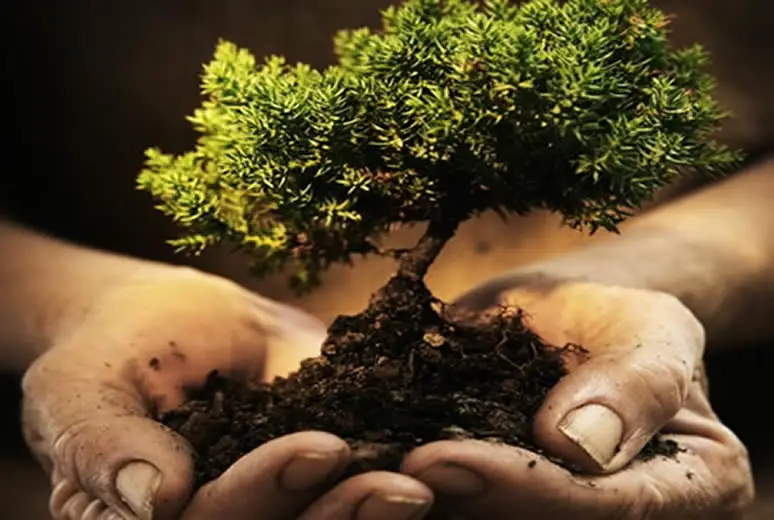Every large garden needs at least 1 tree in my opinion. Trees tend to give a garden a more pleasing look. Plus the shade offered by trees in the summer and the protection from the harsh elements in the winter make them both practical and aesthetically pleasing.
So, in this tree planting guide you’ll learn how to ensure any tree you plant thrives in your garden.
Planting trees in your garden will also allow you to increase your privacy through natural screening. If your garden sits at the back of an industrial site, or other less-than-beautiful surroundings, or if your neighbor has an overlook the quickest solution is to plant some fast growing trees from bare root.
Table of Contents
Ideal tree types for yard use
Conifers such as Pinus nigra ssp.nigra the Australian pine can offer great screening and is prickly enough to keep out unwanted animals and pets. Thuja plicata ‘Excelsa’ also grows fast and offers great screening all year round.
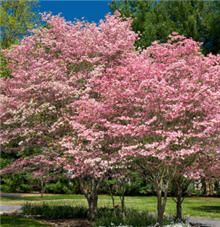 However, you are not restricted to standard choices and can get rather creative.
However, you are not restricted to standard choices and can get rather creative.
American Red Maple and October Glory Maple both grow exceptionally fast have a full foliage that is great for screening and burst to life with orange leaves. Using colourful trees is also a great way to diversify and add to the overall aesthetic feel of a romantic garden.
The Red Rocket Crape Myrtle or Tuscarora Crape Myrtle, along with the Arapaho Crape Myrtle, offer you the ability to use reds in your natural screen.
In fact you can find a fast growing tree to suit your particular taste in a variety of colours from the rustic hues of the Ginkgo Tree to the soft pink of the Dogwood.
For multiple reasons, and especially if you want to plant trees for screening purposes, you should choose either evergreen varieties that are native to your area (where there are some) or alternate between trees that bloom at different times of the year; you do not want full privacy in the summer but little to no privacy in the winter months as the weather strips your trees down to bare branch.
Some people have even used this tree planting guide to plant and grow their own Christmas tree.
The 4 ways to planting trees
Apart from growing from seed there are 4 popular ways to plant a tree.
- Bare Root Planting.
- Balled & Burlapped.
- Cuttings.
- Containerized.
Let’s look at each of these in turn.
1. Bare root tree planting is the common way to plant a tree
Once you have a tree it will come packaged to protect the roots. Unpack your tree being careful not to damage the roots when removing the packing materials. Carefully untangle roots that are clumped together and then soak the roots in fresh water for about 3 to 6 hours. The roots should never be allowed to dry out at this initial stage of planting.
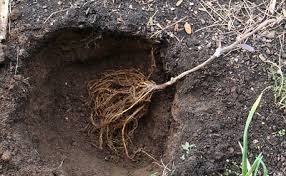 Start by digging a hole deep enough to house the entire root and a several inches above it. Make the hole a good deal wider than the width of the tree so the roots can easily grow through broken soil and don’t have to work hard to puncture hardened soil.
Start by digging a hole deep enough to house the entire root and a several inches above it. Make the hole a good deal wider than the width of the tree so the roots can easily grow through broken soil and don’t have to work hard to puncture hardened soil.
Also remove any grass or other plants within a 3 foot circular area as these will compete for resources. To further encourage root growth turn the soil with a spade, hue or garden fork in an area up to 3 feet in diameter around the planting area.
When you start to fill the hole around the tree pack in the soil firmly around the lower roots being careful not to damage them. Fill the rest of the hole with soil packing it fairly tightly but not compacted as tightly as the lower roots.
At this early stage it is best not to use fertilizer, potting soil, or any type of chemicals on your new trees or the soil surrounding it.
Water the tree generously.
You can also add a layer of mulch around the tree base a few inches deep and about 3 foot in diameter but make sure the mulch does not touch the tree itself: leave a few inches space from the base of the tree before you start mulching.
Keep the soil and mulch moist by watering regularly ensuring they don’t dry out. Keep an eye on your tree for the first 6 months to a year watering it once a fortnight or once a week if it looks like the soil is drying out.
How to plant a tree the bare root way (video)
2. Balled & burlapped tree planting
For this type of planting you will have to be a little more precise in your digging. Start by digging a saucer shaped hole as deep as the root ball. You need to initially measure the depth of the root ball and make sure the hole you dig matches that measurement to make sure the root collar is at ground level (or just above ground level) when the planting is complete. You do not want the root collar covered.
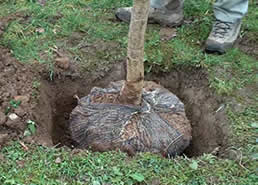 Make sure the width of the hole is two to three times wider than the width of the root ball. Give each side of the hole a slope but leave the soil at the bottom of the hole undisturbed.
Make sure the width of the hole is two to three times wider than the width of the root ball. Give each side of the hole a slope but leave the soil at the bottom of the hole undisturbed.
Never lift the tree by its branches or by its trunk. Always lift it by the root ball or you risk damaging your tree.
Place the tree in the hole checking that the root collar is at ground level or just slightly above it.
If the root collar looks like it is below ground level you will need to add some soil to the base of the hole, directly where the root ball will sit to elevate it.
When you are happy with the tree position, it’s time to cut away the wire basket protecting the tree roots. Cut vertically up the side the wire basket and peel it away. Remove all packaging covering the ball and any nails that are holding the burlap together.
Pull the burlap back and cut away any loose material. If there is any regular burlap under the root ball you can leave it there. However, all vinyl or obvious treated burlap must be removed before planting.
When you are sure the tree is in position and standing straight start to firmly pack soil around the root ball. Fill in the hole until you reach the root collar and try to leave it just slightly above soil level.
Water the tree generously.
You can add mulch in a diameter of several feet around the tree making sure it does not touch the tree itself; leave several inches space between the mulch and the tree trunk.
Keep the soil moist by watering regularly for the first 6 months to a year but do not water-log it.
How to plant a balled and barlapped tree (video)
3. Tree planting using cuttings – the 2 approaches
When planting trees from cuttings you should be aware of the tree type you are working with before beginning.
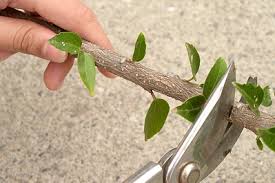 For planting trees from cuttings we can view trees as being of 2 types.
For planting trees from cuttings we can view trees as being of 2 types.
Each requires a slightly different method for planting from cuttings.
The 2 types are:
- Hardwood.
- Softwood
When working with hardwood cuttings you should aim to plant the cutting in early spring or very early winter when the tree is not actively growing. This has less to do with the new cutting than the parent tree. Taking a cutting in a non-growth period reduces the risk of causing stress to the tree and creating potential growth problems for it.
You can also source hardwood cuttings in the fall when a tree naturally shed its leaves. Obviously you will not be able to do this with evergreen plants and must therefore take the cutting yourself.
On the flip side softwood cuttings are best sourced while the tree is in an active growth period – usually in spring or early summer.
Of course you can take cuttings from either type of tree at any time of the year but the above mentioned times give you much more chance of successfully cultivating a healthy tree.
a) Hardwood tree planting
Cut a branch that is 12 to 48 inches in length just above a leaf. At the end that is to be planted pull off or cut all leaves. This will help roots grow from those areas.
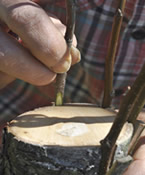 Be sure that the cutting will be at least 6 inches long above ground level.
Be sure that the cutting will be at least 6 inches long above ground level.
Place the lower part of the cutting with the leaves removed into a rooting hormone that you can get from Amazon and then put that end into a small pot or propagator filled with damp soil-less mix from Amazon.
If you are not using a propagator or a propagator kit from Amazon wrap the entire potted cutting in a clean clear plastic bag. Ensure the bag does not touch the cutting.
Place the propagated plant in a warm light spot but not in direct sunlight.
Check the cutting for root growth once a fortnight. Once roots have fully developed (don’t remove it too soon when the roots are only small and fragile) remove the plastic covering or take the plant out of the propagator.
If you used a pot you can continue growth outdoors if the weather is suitable. If you used a propagator simply replant the tree in an appropriate container or plant directly into the ground (though you will have more control over growth if you leave it in a pot as you can move the plant if the weather gets undesirable).
b) Softwood tree planting
Take a cutting that is at least 6 inches in length but avoid using a cutting longer than 12 inches just above a leaf. At the end that is to be planted pull off or cut all leaves but make sure the cutting has at least 3 to 4 leaves on the bit that will be above soil level. This will help roots grow from those areas.
Cut the remaining leaves in half. This will help to reduce water loss.
Place the lower part of the cutting with the leaves removed into a rooting hormone you can get one from Amazon or your local supplier and then put that end into a small pot or propagator filled with damp soilless mix like this one from Amazon.
If you are not using a propagator or a propagator kit from Amazon wrap the entire potted cutting in a clean clear plastic bag. Ensure the bag does not touch the cutting.
How to plant a tree using cuttings (video)
4. Tree planting from containers – replanting mature trees
Dig a hole about 3 to 4 times wider than the container and deep enough that you could place the tree into the hole and cover the container. Make sure the sides of the hole are sloping to allow for good root growth.
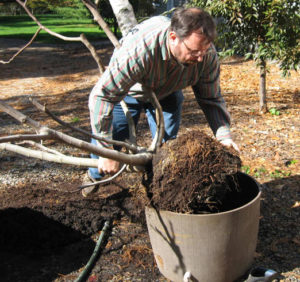 Take care not to damage the roots when removing the tree from the container. Don’t pull it out from the trunk as you risk damaging the tree itself.
Take care not to damage the roots when removing the tree from the container. Don’t pull it out from the trunk as you risk damaging the tree itself.
Instead turn the tree on its side and gently tap the bottom of the container until you can slide the tree out.
Depending on how long the tree has been in the container it may be root bound; the roots are either starting to or already circle the outside of the root ball.
If this is the case, then simply cut an “X” shape at the bottom of the ball and make 3 or 4 cuts to the side of the root ball also.
Place the tree in the hole ensuring the root collar is at ground level or slightly above it. If the hole is too deep simply fill the hole with a little soil directly where the root ball will sit until there is enough to elevate the root collar to its desired height.
Make sure the tree is straight before filling the bottom of the hole with soil and packing it in firmly at the root. As the hole fills pack the soil less tightly.
Water the tree generously.
Once the soil has soaked up the water take some mulch and, a few inches away from the trunk of the tree, begin spreading it out in a 3 or 4 feet diameter 2 to 4 inches deep.
Keep the soil moist by watering regularly and never allow it to dry out for the first 6 months to 1 year.
Avoid using any chemicals including fertilizer as this can damage and even kill your tree at this early stage of growth.

